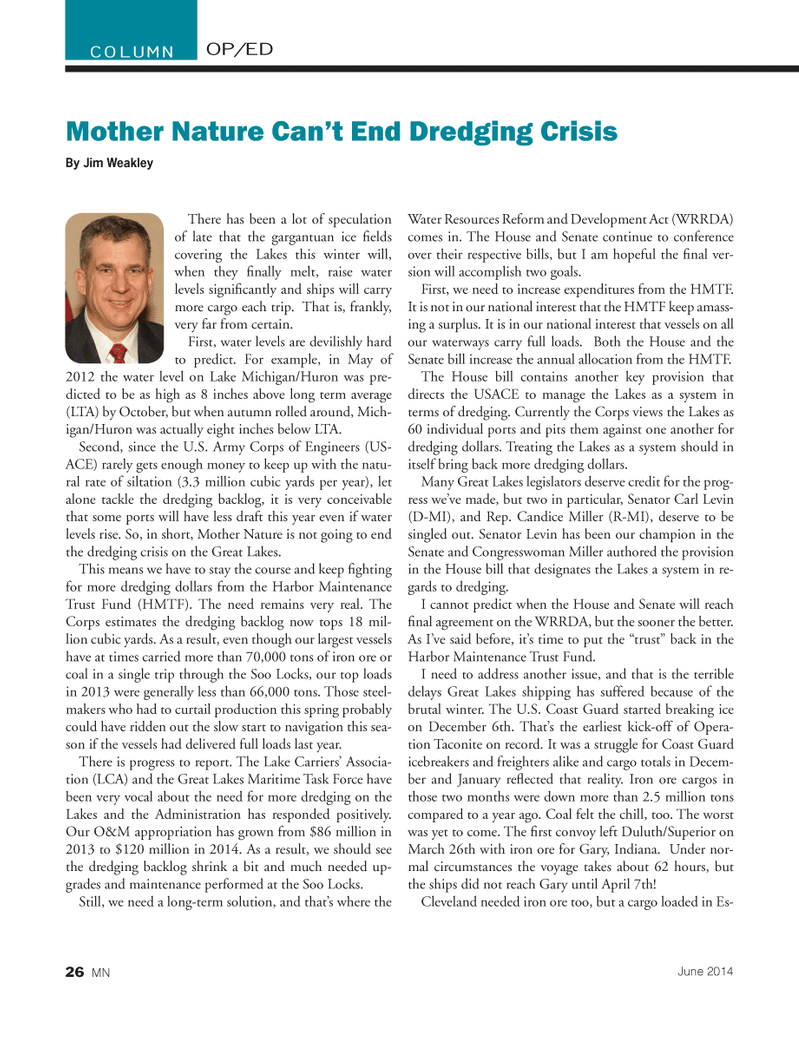
Page 26: of Marine News Magazine (June 2014)
Dredging & Marine Construction
Read this page in Pdf, Flash or Html5 edition of June 2014 Marine News Magazine
There has been a lot of speculation of late that the gargantuan ice Þ elds covering the Lakes this winter will, when they Þ nally melt, raise water levels signiÞ cantly and ships will carry more cargo each trip. That is, frankly, very far from certain. First, water levels are devilishly hard to predict. For example, in May of 2012 the water level on Lake Michigan/Huron was pre- dicted to be as high as 8 inches above long term average (LTA) by October, but when autumn rolled around, Mich- igan/Huron was actually eight inches below LTA. Second, since the U.S. Army Corps of Engineers (US- ACE) rarely gets enough money to keep up with the natu- ral rate of siltation (3.3 million cubic yards per year), let alone tackle the dredging backlog, it is very conceivable that some ports will have less draft this year even if water levels rise. So, in short, Mother Nature is not going to end the dredging crisis on the Great Lakes. This means we have to stay the course and keep Þ ghting for more dredging dollars from the Harbor Maintenance Trust Fund (HMTF). The need remains very real. The Corps estimates the dredging backlog now tops 18 mil- lion cubic yards. As a result, even though our largest vessels have at times carried more than 70,000 tons of iron ore or coal in a single trip through the Soo Locks, our top loads in 2013 were generally less than 66,000 tons. Those steel- makers who had to curtail production this spring probably could have ridden out the slow start to navigation this sea- son if the vessels had delivered full loads last year. There is progress to report. The Lake CarriersÕ Associa- tion (LCA) and the Great Lakes Maritime Task Force have been very vocal about the need for more dredging on the Lakes and the Administration has responded positively. Our O&M appropriation has grown from $86 million in 2013 to $120 million in 2014. As a result, we should see the dredging backlog shrink a bit and much needed up- grades and maintenance performed at the Soo Locks. Still, we need a long-term solution, and thatÕs where the Water Resources Reform and Development Act (WRRDA) comes in. The House and Senate continue to conference over their respective bills, but I am hopeful the Þ nal ver- sion will accomplish two goals.First, we need to increase expenditures from the HMTF. It is not in our national interest that the HMTF keep amass- ing a surplus. It is in our national interest that vessels on all our waterways carry full loads. Both the House and the Senate bill increase the annual allocation from the HMTF. The House bill contains another key provision that directs the USACE to manage the Lakes as a system in terms of dredging. Currently the Corps views the Lakes as 60 individual ports and pits them against one another for dredging dollars. Treating the Lakes as a system should in itself bring back more dredging dollars. Many Great Lakes legislators deserve credit for the prog- ress weÕve made, but two in particular, Senator Carl Levin (D-MI), and Rep. Candice Miller (R-MI), deserve to be singled out. Senator Levin has been our champion in the Senate and Congresswoman Miller authored the provision in the House bill that designates the Lakes a system in re- gards to dredging. I cannot predict when the House and Senate will reach Þ nal agreement on the WRRDA, but the sooner the better. As IÕve said before, itÕs time to put the ÒtrustÓ back in the Harbor Maintenance Trust Fund. I need to address another issue, and that is the terrible delays Great Lakes shipping has suffered because of the brutal winter. The U.S. Coast Guard started breaking ice on December 6th. ThatÕs the earliest kick-off of Opera- tion Taconite on record. It was a struggle for Coast Guard icebreakers and freighters alike and cargo totals in Decem- ber and January reß ected that reality. Iron ore cargos in those two months were down more than 2.5 million tons compared to a year ago. Coal felt the chill, too. The worst was yet to come. The Þ rst convoy left Duluth/Superior on March 26th with iron ore for Gary, Indiana. Under nor- mal circumstances the voyage takes about 62 hours, but the ships did not reach Gary until April 7th! Cleveland needed iron ore too, but a cargo loaded in Es- OP/EDCOLUMNMother Nature Can?t End Dredging CrisisBy Jim Weakley June 201426 MNMN June14 Layout 18-31.indd 26MN June14 Layout 18-31.indd 265/20/2014 10:31:42 AM5/20/2014 10:31:42 AM

 25
25

 27
27
